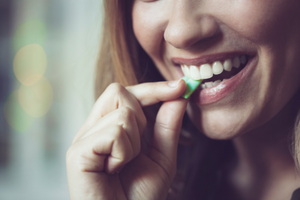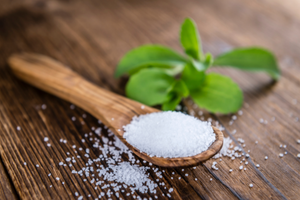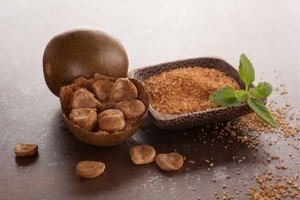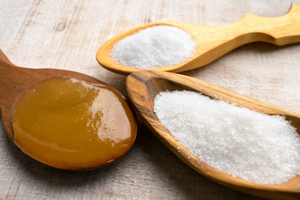Sugar-free sweeteners are a great way to cut down on sugar without sacrificing sweetness. There are many different types of sugar substitutes available on the market, so it can be tricky to figure out which one is right for you. In this article, we will discuss the different types of sugar-free sweeteners and provide tips for choosing the best option for your needs.
Table of Contents
- A Brief History of Sugar-Free Sweeteners
- The Different Types of Sugar-Free Sweeteners
- Tips for Choosing the Best Option for Your Needs
- What to Consider When Buying a Sugar-Free Sweetener
- How to Store Sugar-Free Sweeteners
- How to use sugar-free sweeteners
- Sugar-free sweeteners for weight-loss
- Frequently Asked Questions about sugar-free sweeteners
A Brief History of Sugar-Free Sweeteners
Sugar-free sweeteners have been around for centuries. The first sugar-free sweetener was honey, which was used by the ancient Egyptians in religious ceremonies. Other early sugar-free sweeteners included molasses and corn syrup. In the late 1800s, artificial sweeteners were developed, and they quickly became popular due to their low-calorie and sugar-free properties.
Today, there are many different types of sugar-free sweeteners available on the market. Each type has its own unique set of benefits and drawbacks, so it can be tricky to figure out which one is right for you.
The Different Types of Sugar-Free Sweeteners
– Artificial sweeteners
Artificial sweeteners are much sweeter than sugar and a little goes a long way. Start with a small amount and work your way up until you find the sweetness level that’s right for you.

The most common types of artificial sweeteners are:
• Saccharin – This was one of the first artificial sweeteners on the market and is still commonly used today. It’s sold under the brand names Sweet’N Low and Necta Sweet.
• Aspartame – This sweetener was approved by the FDA in 1981. You can find it in diet soft drinks, gelatin desserts, frozen desserts, puddings and fillings, chewing gum and other sugar-free products. It’s also sold under the brand names NutraSweet and Equal.
• Acesulfame potassium (Ace-K) – This sweetener was approved by the FDA in 1988. It’s often used in combination with other artificial sweeteners. You can find it in sugar-free soft drinks, baked goods, candy, desserts and other products.
• Sucralose – This sweetener was approved by the FDA in 1998. It’s sold under the brand name Splenda and is often used in combination with sugar. You can find it in many processed foods, including soft drinks, yogurt, ice cream and baking mixes.
Artificial sweeteners are often referred to as having virtually no calories because they are not metabolised in our cells. However they have been found to cause cancer, disrupt hormones and enzymes, change the composition of gut bacteria and promote weight gain.
Personally, I avoid all artificial sweeteners.
– Sugar alcohols
Sugar alcohols are a type of sugar-free sweetener that is made from sugar. They are typically used in combination with other sweeteners to improve the taste and texture of foods.
The most common types of sugar alcohols are:
• Sorbitol – This sweetener is found in many processed foods, including candy, gum, ice cream and cookies. It’s the main ingredient in Orbit chewing gum.

• Xylitol – This sweetener is found in many dental products, such as toothpaste and mouthwash. It’s also sold under the brand names Biotene and Xylichew.
• Mannitol – This sweetener is used in many food products, including candy, ice cream and chewing gum. It’s also sold under the brand name Sunett.
• Erythritol is a type of sugar alcohol that is used as a sugar substitute. It is made from corn starch and can be found in many processed foods, including candy, gum, ice cream and cookies. Erythritol does not cause a significant increase in insulin levels.
Sugar alcohols have fewer calories than refined sugar, however, they can cause digestive problems, such as gas, bloating and diarrhea. They can also promote tooth decay.
There is some controversy over whether sugar alcohols can cause blood sugar and insulin to spike. A small study published in the Journal of the American Dietetic Association found that consuming 10 grams of sugar alcohols caused a significant increase in insulin levels. However, other studies have found that sugar alcohols do not cause a significant increase in blood sugar and insulin levels. more research is needed to determine whether sugar alcohols can cause insulin to spike.

– Natural sweeteners
Natural sweeteners are made from plants or fruits. The most common types of natural sweeteners are:
• Stevia – This sweetener is made from the leaves of the stevia plant. It’s available in liquid and powder form, as well as a tabletop sweetener. It can also be bought under the brand name Truvia.
• Monk fruit extract (Luo Han Guo) – This sweetener is made from the fruit of a plant native to China. It can be bought under the brand name Monk Fruit in the Raw.
• Honey – This sweetener is made by bees and has been used for thousands of years as a sweet food source.
• Thaumatin is a natural sweetener that is made from the Katemfe plant (Thaumatococcus Daniellii). It can be bought under the brand name SweetLeaf.
• Maple syrup is a natural sweetener that is made from the sap of maple trees.
• Agave nectar is a natural sweetener that is made from the agave plant.
Natural sweeteners are great sugar substitutes and are considered to be healthier than artificial sweeteners but your choice will depend on your needs.
Honey, maple syrup, and agave are great options if you are just starting to cut out sugar from your diet. However, they are a source of glucose and fructose so they still raise blood sugar levels resulting in insulin being released into your blood.
Stevia, monk fruit and thaumatin are my personal favorite sugar-free sweeteners as they don’t raise blood sugar levels.

Tips for Choosing the Best Option for Your Needs
1. Compare the ingredients list of each product to find the best option for your needs.
2. Consider how the sweetener will be used – is it for baking, drinking, or both?
3. Compare prices and find the best value for your needs.
4. Read reviews to learn more about other people’s experiences with different sugar-free sweeteners.
5. Talk to your doctor or nutritionist if you have any questions about which sugar-free sweetener is best for you.
What to Consider When Buying a Sugar-Free Sweetener
When looking for a sugar-free sweetener, there are a few things you’ll want to consider. The most important thing is to find an option that fits your dietary needs and taste preferences. Here are a few other things to keep in mind:
-Price: Sugar-free sweeteners can vary in price, so it’s important to find one that fits your budget.
-Availability: Not all sugar-free sweeteners are available at every store, so it’s important to do your research and find the one that’s easiest for you to access.
-Ingredients: Make sure to read the ingredients list before purchasing a sugar-free sweetener. Some sweeteners contain unhealthy ingredients like artificial sweeteners or high levels of sugar alcohols, which can be difficult for your body to digest. If you have a sensitivity or allergy to any of these ingredients, make sure that they don’t appear on the label!
-Taste: This is probably one of the most important things when it comes down to choosing a sweetener – do you like how it tastes? Some sugar-free sweeteners are more artificial tasting than others, so it’s important to find one that you enjoy using.

How to Store Sugar-Free Sweeteners
When you’ve chosen the sugar-free sweetener that’s best for you, it’s important to know how to store and use it. All sugar-free sweeteners should be stored in a cool, dry place. This will extend the shelf life of the product and prevent any bacteria from growing. Most sugar-free sweeteners have a shelf life of two years or more, but it’s always a good idea to check the expiration date on the package before purchasing.
How to use sugar-free sweeteners
Sugar-free sweeteners can be bought in a variety of forms, including liquid, powder and granulated. The most common type of sugar-free sweetener is Stevia, which is available in all three forms.
When it comes to using sugar-free sweeteners, there are a few different methods you can use. You can add them directly to food or drinks, mix them with other ingredients to create a recipe, or dissolve them in water or another liquid before adding them to food or drinks. Experiment with different methods and find the one that works best for you.
Sugar-free sweeteners for weight-loss
If you want to lose weight then the best sugar substitutes are ones that do not raise blood sugar levels.
As soon as your blood sugar levels increase then your pancreas will release insulin into your blood. Insulin acts as a key to let glucose into your cells. It then gets converted to fat if it isn’t used.
So you need to be mindful about controlling blood sugar.
Thaumatin, being a protein, does not spike blood sugar levels. It is the sweetener in my favorite chocolate protein powder that I use in several of my healthy chocolate treat recipes in my free eBook. Get my free recipe ebook here.
Frequently Asked Questions about sugar-free sweeteners
What is the best sugar-free sweetener for iced tea?

There is no one-size-fits-all answer to this question, as everyone’s taste preferences vary. However, some good options for sugar-free sweeteners in iced tea are liquid Stevia, Truvia Nectar, and Sweet’n Low Liquid. Experiment with different sweeteners to find the one that you like best.
Is there a sugar-free sweetener that tastes like sugar?
No sugar-free sweetener tastes like sugar as each type has a different flavor profile to emulate different types of sugars.
The only time a sugar-free sweetener will taste remotely similar to table sugar is when it is used in large quantities.
How do I use liquid sugar-free sweeteners?
You can use liquid sugar-free sweeteners in your coffee, tea or other hot drinks. If you’re tired of diet soda but still want carbonation, you could use one cup of water and add 1 tbsp. of liquid sugar-free sweetener for a healthy alternative to those flavored sodas that come with all the added sugars!
Can I bake with granulated sugar-free sweeteners?
Yes, you can use granulated sugar-free sweeteners in baking.
There are a variety of granulated sugar-free sweeteners that you can use in baking just like regular sugar. My favorite blend is made from Erythritol + monkfruit.
What is the difference between Stevia and Splenda?
Stevia is from a plant whereas Splenda is an artificial sweetener.
Sugar-free sweeteners are a great way to reduce sugar intake, but there are many different types of sugar substitutes out there. The best option for one person may be the worst choice for another.
It is always important to read labels and research before making any purchase decision so that you know exactly what you’re getting into! In this article we’ve covered all the basics about sugar-free sweeteners including artificial sweeteners, sugar alcohols and natural sweeteners.
